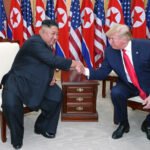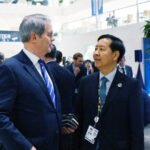Samsung memory business chief Lee Jung-bae at Semicon Taiwan 2024
TAIPEI – Samsung Electronics Co. and SK Hynix Inc., the world’s two largest memory chipmakers, are racing to supply their advanced DRAM chips to their clients, including Nvidia Corp. to enjoy the Al boom.
Executives from the two South Korean companies said on Wednesday they are doing their utmost to produce the latest high-bandwidth memory (HBM) chips in large quantities at the earliest possible time.
“To maximize the performance of AI chips, customized HBM is the best choice. We are working with other foundry players to offer more than 20 customized solutions,” said Lee Jung-bae, corporate president and head of Samsung’s memory business, during a keynote speech at Semicon Taiwan 2024, an international gathering of semiconductor professionals.
He said Samsung is preparing to unveil a 256 terabyte (TB) solid-state drive (SSD) for servers to meet growing demand for high-capacity storage devices in AI servers.
Justin Kim, president and head of AI Infra at SK Hynix. gives a keynote speech at Semicon Taiwan 2024
Justin Kim, president and head of AI Infra at SK Hynix, said during his keynote speech that “we’re closely working with TSMC to develop HBM 4. Our development is going smoothly so we expect to supply the chip to our clients at the right time.”
Semicon Taiwan 2024, organized by chip industry association SEMI, features over 1,100 chip-related enterprises at 3,700 booths – a 22% increase from last year, according to SEMI Taiwan.
Under this year’s theme “Breaking Limits: Powering the AI Era,” which highlights the industry’s key role in AI and next-generation technologies, the event, will be held from Wednesday through Friday, at the Taipei Nangang Exhibition Center.
Organizers said this year’s event brings leaders from the world’s top tech firms to Taipei to discuss industry trends at forums, including the CEO Summit.
Samsung’s high-performance chip products
Participating firms at the CEO Summit include Taiwan Semiconductor Manufacturing Co. (TSMC), ASE Technology Holding Co. (ASE), Applied Materials Inc., Google LLC, Samsung, SK Hynix, Microsoft Corp, Interuniversity Microelectronic Centre (IMEC) and Marvell Technology Group Ltd, according to SEMI.
Top executives will delve into how semiconductors are positioned as the driving force behind global technological innovation amid the artificial intelligence revolution, organizers said.
RACE FOR HBM SUPREMACY
Global chipmakers are racing to take advantage of the AI boom, which is driving demand for logic semiconductors such as processors.
SK Hynix’s HBM3E, the extended version of the HBM3 DRAM chip
HBM has become an essential part of the AI boom, as it provides the much-needed faster processing speed compared with traditional memory chips.
Among memory chipmakers, SK Hynix is the biggest beneficiary of the explosive increase in AI adoption, as it dominates the production of HBM, critical to generative AI computing, and is the top supplier of AI chips to Nvidia, which controls 80% of the AI chip market.
SK Hynix said last month it aims to supply its latest 12-layer HBM3E chips in large quantities to Nvidia in the fourth quarter.
SK said it will begin mass production of the chip near the end of this month.
Nvidia is the world’s top AI chip designer
To hold its lead, SK joined hands with TSMC, the world’s top foundry or contract chipmaker, in April to develop next-generation AI chips, called HBM4, next year.
Samsung, which has passed Nvidia’s qualification tests for its HBM3 chips, is striving to gain the US AI chip designer’s approval for its HBM3E chips.
By Chae-Yeon Kim and Jeong-Soo Hwang
why29@hankyung.com
In-Soo Nam edited this article.















